Header logo
header top contact widget
Dental Technology
Asheville Periodontic Specialty Office Offers Latest To Enhance Treatment Outcomes, Comfort.
Posted on May 13, 2019 by William J. Claiborne, DDS MS
As an Asheville NC periodontist, I know it is more than my specialized skills that keep us busy. Many dentists and other dental specialists refer patients to our office because they know each patient receives optimal care with a gentle, respectful touch.
Another thing we are known for is the state-of-the-art technology we use to save patients time while they achieve the very best results in minimal treatment time. Some of our advanced features available include:
LANAP Protocol Using PerioLase MVP-7 – An acronym for Laser-Assisted New Attachment Procedure, LANAP provides an advanced protocol to more efficiently and effectively treat periodontitis (advanced gum disease) with the PerioLase® MVP-7™ laser. This offers a minimally invasive (non-surgical) treatment alternative for patients with moderate to severe periodontal disease.LANAP treatment leaves very little discomfort and has a quick recovery time. It has also been found to stimulate bone regrowth in damaged areas.
Dental Radiology With 3-D Cone Beam Technology – We rely on 3D imaging in diagnostic and treatment planning. This latest level of 3D imaging covers the whole dentition area, giving a clear view of the mandible and maxilla (upper and lower jaw) for intricate review for the diagnostic requirements of endodontics, periodontics, orthodontics, implantology, TMJ and prosthodontics as well as dental and maxillofacial surgery.
In addition to imaging, cone beam radiographs provide images in sagittal, axial, and coronal planes. This makes it possible to locate and trace the mandibular nerve canal for pre-surgical planning for an ideal implant position.
We also like that our patients are exposed to only minute levels of radiation through a process that is fast and comfortable.
CareStream Cone Beam Computer Tomography Imaging – Our office features the Carestream 9300. This Cone Beam Computer Tomography provides dual modality panoramic and 3D imaging with exceptional detail and range. The CS 9300 can deliver 3D imaging at a significantly lower dose than 2D panoramic imaging. In fact, in a recent study, the CS 9300 and CS 9300 had up to an 85% lower radiation dose than traditional panoramic imaging.
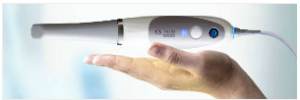
Carestream 3600
CS 3600 intraoral scanner – No longer do our patients have impressions made with bulky, goopy trays held in their mouths!
The CS 3600 Scanner is designed to quickly and comfortably scan areas inside our patient’s mouth. It acquires digital impressions accurately and easily, scanning a full or dual arch for the fabrication of digital models or appliances.
The CS 3600 provides a highly accurate digital impression using a small, handheld scanner. It can also reach difficult–to–access areas in the patient’s mouth for superior results with improved patient comfort.
Just some of the superior features of the CS 3600 Scanner include:
• Acquires digital impressions to design crowns, inlays, onlays, bridges, orthodontic appliances and aligners, custom abutments and RPD;
• Has an Intelligent Matching System that prevents missing data in any area. Plus, it even sends a warning to indicate areas of the scan that lack detail;
• Has adaptive hole filling that automatically identifies holes and selects the appropriate anatomical color for optimal aesthetic outcomes;
• Enhances outcomes for restorations, orthodontics and implants; and,
• Displays precise, accurate HD 3D color images with vivid color and details for improved case review, analysis and communication between doctors, referrals and labs.
Simplant Dental Software for Computerized Dental Implant Placement – This advanced software system allows for pre-surgical positioning of dental implants on the computer using a 3D model of the patient’s jaw. Once the implant type is selected, a surgical template is developed that ensures a precision fit. Simplant creates optimal implant treatment success, even for complex cases. It also simplifies the team treatment process so intricate aspects of the surgical process can be discussed prior to placement.
Intraoral Camera Technology – This self-contained intraoral camera features full motion video with outstanding image quality from an internal camera that captures ideal angles and images with the click of a button. The images are sent to screen for a clear, crisp view so we can confer with patients on specific treatment issues.
Computer Imaging In Treatment Suites – Treatment suites are equipped with computers for convenient image sharing with patients. This allows patients to have a more complete understanding of their individual needs through images that can be pulled up by our dental team, with the ability to enlarge certain areas to show specific details. Through this, patients have greater involvement in treatment decisions.
Advanced Sterilization – Our custom sterilization unit is designed to adhere to or exceed established Centers For Disease Control & Prevention (CDC) guidelines for instrument processing protocols. Intuitive colored lighting identifies the receiving and cleaning of instruments.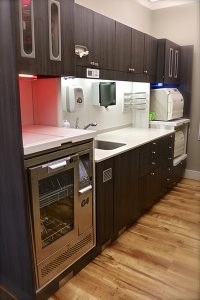
Fully-Equipped Surgical Suites – Relax during treatment (under sedation, if desired) while you are surrounded with the serene views surrounding our Asheville periodontal office.
So you see, we are committed to providing each patient with advanced skills, experience, comfort, and technology that provides the very best in periodontal and dental implant treatment available.
If you have experienced periodontal (gum) disease or are considering gum recontouring or tooth replacement with dental implants, being referred is not always needed. Call our friendly staff to discuss your needs: 828-274-9440.
Scared? Afraid? Simple Steps To Get Past Dental Fears.
Posted on Apr 30, 2019 by William J. Claiborne, DDS MS
If you’re one of those people who have no dread of going to see a dentist, be glad. For the large percentage of adults who do experience anxiety or fear associated with dental visits, they are actually in the majority.
In the U.S., an estimated 70 percent of adults have some level of dental fear, unfortunately. About 5-10 percent of them can be categorized as “dental phobics.” These individuals have such an intense fear of dental visits that the mere thoughts of walking into an office causes reactions such as sweating or more rapid breathing.
As a periodontist, I’m a frequent witness to just how severe dental fears can be. Some people cry, some keep a white-knuckled grip on the arms of a dental chair (once they finally talk themselves into one), and some ask to be put to sleep for things as minor as dental cleanings.
 The periodontal specialty provides patients with a dental professional who has advanced training in the diagnosis and treatment of gum disease. It also covers the diagnosis and placement of dental implants, which are the “ideal” tooth replacement. In this field, I’ve seen the repercussions of both due to dental fear.
The periodontal specialty provides patients with a dental professional who has advanced training in the diagnosis and treatment of gum disease. It also covers the diagnosis and placement of dental implants, which are the “ideal” tooth replacement. In this field, I’ve seen the repercussions of both due to dental fear.
By not receiving regular dental cleanings and exams, the risks for developing gum disease rise significantly. And, since gum disease is the leading cause of adult tooth loss, it plays a key role in one’s potential to lose natural teeth.
Dental fear leads to a vicious cycle of poor oral health and tooth loss. When people are too afraid to see a dentist for regular care and fail to have small problems repaired while treatment needs (and costs) are still minimal, the process is ongoing. As gum health declines, the risks for tooth loss increases.
No one wants to end up in dentures. While TV commercials for denture adhesives or same-day denture clinics try to come across as upbeat, life wearing a denture is anything but. Long-time denture wearers struggle to bite, chew, and even speak without worrisome, uncomfortable slips or rubbing against tender gum tissues.
Too, the uncertainty of a denture can make some people uneasy when dining out or in other social settings. It’s not unusual for denture wearers to decline invitations when food is a key centerpiece of the gathering. This is sad. It is also detrimental to one’s health. Social involvement is an important part of our overall well-being.
If you are among those who avoid dental care because of uncontrollable jitters or downright “scared” feelings, below are several steps you may wish to consider to help you move past them:
• Begin by writing down what you believe caused your fears in the first place. Was it a painful procedure? Was it a rough dentist who ignored your obvious discomfort? If you know what sparked your fear in the first place and can look-it-in-the-eye in actual words, you can begin to deal with them. This may help you bring them out of the shadows and into the light where you can begin to conquer them.
• Close your eyes and imagine your life with a healthy smile — one that makes you feel good about being close to others. Imagine conversations having fresh breath and smiling with confidence. Imagine getting compliments on your smile! Think about how you may interact more confidently with others with a smile you’re proud to share.
• If you haven’t seen a dentist on a regular basis, you may need to begin with a periodontal examination. You can do an internet search (Periodontist) in your area and get to know them through their web sites. Read the doctor’s bio and become familiar with what he or she offers in terms of technology and comfort options. When a periodontist keeps current on the techniques and technology surrounding this specialty, patient comfort is typically a leading factor among these features.
• Visit the periodontist’s office after hours. Yes, go there when they are closed so you’ll feel less intimated. Sit in the parking lot and imagine where you’d park for your visit, once scheduled. Walk up to the entrance and become familiar with the look of the entryway. This way, when your appointment is made, you’ll feel more comfortable making your way in the door.
• Call the office and be comfortable sharing your concerns. Don’t feel shy about saying, “I have a lot of dental fear and would like to begin by meeting the doctor.” Most offices have these conversations with new callers more often than you realize. As mentioned prior, dental fear and anxiety are fairly common. Most offices offer an initial consultation so you can get to know the doctor before scheduling an exam. Ask about where this consult will be held. The periodontist should have a private room available for this, where it is not part of the clinical side of the practice.
• The day of your appointment, call the office and ask about anticipated waiting time for your appointment. Most offices run on-time and your wait should be less than 15 minutes. However, unforeseen emergencies do arise that may disrupt an on-time schedule. If delayed, consider rescheduling. Having a lengthy wait time may add to your anxiety and it may be best to arrange another visit.
• When you go, take a book, newspaper, or favorite magazine for your wait time. Don’t assume that the periodontist has a selection you’ll be interested in. Some people like to work a crossword or ‘Jumble’ during their brief wait here.
• When meeting the doctor or staff, know that it is important to be straight-forward about your fear level. Don’t gloss over it. Being upfront will help the doctor tailor your care to address your fears or concerns at an appropriate level.
• Ask the doctor about comfort options, including sedation. Both oral and IV sedation (twilight sleep) should be available. Feel free to ask questions about how they are administered, recovery time, and safety monitoring measures. Your safety is as important as your comfort.
• Finally, listen to your gut. Did you feel the doctor truly ‘heard’ your concerns? Did you feel the staff was attentive? Did you feel confident in the appearance of the practice? Sometimes, the most important measure of comfort is what that “little voice” inside is telling us. If you don’t feel good about moving forward, consider a consult at another periodontal office. You should leave your consult feeling positive about moving forward.
One of the most satisfying parts of my specialty is watching a once-fearful patient transform into one with a healthy, confident smile! And, the foundation of that is a relationship of trust between the doctor and the patient.
If you are ready to get past your dental fears so you can have the smile you desire, begin by calling our Asheville periodontal office and speaking with our friendly staff at: 828-274-9440. Or, start with the steps listed above and move at a pace that feels best for you.
Our Newest Feature – Technology That Enhances Treatment, Even Reverse Some Damage
Posted on Mar 24, 2019 by William J. Claiborne, DDS MS
Introducing…
LANAP PROTOCOL USING PERIOLASE MVP-7
Dr. William Claiborne and Dr. Jennifer Boyland of Biltmore Periodontics in Asheville are pleased to announce the addition of LANAP® protocol, a laser treatment for gum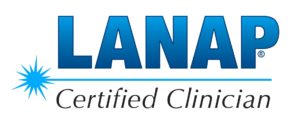 disease. Both Doctors are now Certified LANAP Clinicians, which requires completion of intensive training.
disease. Both Doctors are now Certified LANAP Clinicians, which requires completion of intensive training.
LANAP is an acronym for Laser-Assisted New Attachment Procedure, which provides an advanced protocol to more efficiently and effectively treat periodontitis (advanced gum disease). The LANAP protocol allows Dr. Claiborne and Dr. Boyland to treat gum disease with the PerioLase® MVP-7™ laser. This offers a minimally invasive (non-surgical) treatment alternative for patients with moderate to severe periodontal disease.
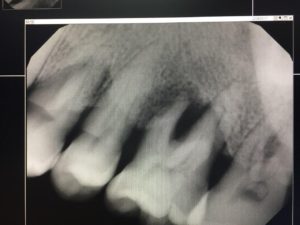
BEFORE (area of bone loss around tooth roots)
LANAP treatment is patient friendly, leaves very little discomfort, and has a quick recovery time. Most patients can resume normal activities in less than 24 hours after treatment. Best of all, LANAP protocol is extremely effective in battling gum disease.
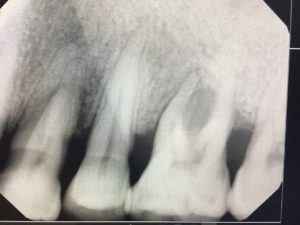
AFTER (showing bone regeneration)
The LANAP protocol uses the PerioLase® MVP-7™ laser instead of a knife or scalpel, avoiding any kind of cutting into the gums and the need for stitches. This reduces the level of discomfort following the procedure. Treatment through LANAP can be performed in as little as one session. It is safe for patients with health concerns such as diabetes, heart disease, and hemophilia.
Additionally, LANAP protocol can even stimulate bone regrowth in damaged areas. For example, it has been shown to regrow periodontal ligament, alveolar bone (the bony ridge that supports the upper teeth), and regrow the bony film that adheres teeth to the jaw. (see BEFORE and AFTER images above)
There are many advantages to this remarkable technology for the patients of Biltmore Periodontics. To learn more about LANAP protocol using the PerioLase MVP-7, as well as other advanced technology the practice features, visit: https://www.biltmoreperiodontics.com/services/advanced-technology/ or call their office at: 828-274-9440.
How To Make Flossing An Easy Part Of Your Oral Care Routine
Posted on Mar 06, 2019 by William J. Claiborne, DDS MS
You can imagine that dental offices hear just about every excuse known to man as to why people “forget” to brush or don’t floss or don’t go to the dentist or don’t proceed with recommended treatment or don’t ….. It’s endless. 
While many patients know their excuses are not really justified reasons, we adults can rationalize just about anything when it comes down to it. We know what may seem unjustified can be true reality for others.
We learn – starting from childhood – how to rationalize certain viewpoints. Some of us justify grabbing something sweet rather than healthy for a “quick pick-me-up.” Some don’t make the bed in the morning because it’s just going to get messed up at night. Some don’t go to the dentist until something hurts because they feel that’s the first sign that something is wrong.
OK, we all know, deep down, that there are things we shouldn’t avoid. No one WANTS to go to a dentist twice a year but also know it’s part of the process for a confident smile and way to avoid cavities and periodontal (gum) disease.
It’s clear that it’s not just these 6-month check-ups and cleanings alone that lower our risks of needing dental repairs and treatment, things that occur that were essentially preventable with daily care. What I’d like to address is the daily care you give to your oral health, and flossing, in particular.
In our Asheville periodontal dental office, we pride ourselves on not “lecturing” our patients. Our goal is to provide sufficient information to each individual, helping him or her understand the HOW & WHY of recommendations.
For instance, here is HOW to brush thoroughly and effectively twice a day. Here is WHY it can save you time and money by preventing or minimizing dental procedures that may be needed in the future.
Brushing one’s teeth effectively and regularly is easily instructed. We advise at least twice a day, using a soft to medium bristle tooth brush and fluoride tooth paste. Using a swirling motion, each individual should spend at least two minutes per brushing, going over all sides and tops of teeth.
And then there’s flossing. This is where the patient starts to twitch and squirm in the discussion. Flossing is a complicated, difficult maneuver in the minds of some people. Yet, for those who floss on a daily basis, it’s a simple technique that takes less than a minute.
The action of flossing helps to dislodge food particles that become trapped between teeth. For older adults who have shrinking gum tissues (a normal part of the aging process), food bits can also become wedged in the tight openings beneath the area where teeth meet one another.
Flossing is a particular need for people who have crowded, crooked teeth. These jumbled angles and nooks offer ideal havens for oral bacteria accumulation. Too, people in orthodontic treatment (braces) are particularly vulnerable to oral bacteria buildup because of the food trapping potential of wires and brackets.
Food that is not removed from the mouth after several hours begins to rot. Rotting particles are sustenance for oral bacteria. This gives them sustenance that helps them reproduce and thrive. As oral bacteria accumulate in the mouth, they begin attacking tooth enamel and gum tissues.
A tooth brush is often unable to dislodge food caught between teeth. This is why the use of floss is beneficial. However, manual floss can be a challenge to some individuals. Some people don’t like the tight feel around their fingers. Some people have large hands and find it difficult to reach certain areas in the mouth. Others have dexterity issues that leave them unable to floss.
Our goal is to create an ideal program for each patient that is customized to their needs and goals. For example, people with large or arthritic hands can STILL floss, simply by using a water flosser.
A water flosser pulsates a stream of water between teeth that is forceful enough to dislodge trapped food bits but without harming teeth or gums. Water flossers are affordable, easy to purchase online or in most stores, and easy to use.
Best of all, most water flossers have been shown to be just as effective as manual flossing. And, because they typically sit out in clear view of the sink where tooth brushing occurs, water flossers help to remind the individual that it’s a part of their at-home oral hygiene routine.
There is always an excuse to avoid doing something we know, deep down, we should be doing. I don’t like taking the trash out at night but know it’s simply part of keeping our home clean and pleasant. Yet, certain tasks are well worth the small steps we take each day to keep things in good shape.
A healthy, confident smile is worth the daily upkeep of regular brushing and flossing. You can also enhance your potential for a healthy mouth by drinking plenty of water throughout the day, limiting sugar and caffeine (which is drying to oral tissues), and avoiding snacking (or select what you snack on wisely).
For patients who have lost natural teeth or have developed periodontal disease due to insufficient oral hygiene care, their regret is a powerful warning to others. We frequently hear, “If I could go back, I’d have taken better care of my teeth.” Let us help you to avoid ever having to say that.
Begin with an examination. We’ll assess the health of your gums and the condition of your teeth. If you have signs of gum disease, we have advanced training and skills to treat all stages of gum disease. We also utilize state-of-the-art technology designed to enhance treatment outcomes and optimize patient comfort.
For individuals who have lost teeth, a periodontist also specializes in the diagnosis and placement of all types of dental implants. Dental implants recreate the strength and stability of natural teeth. Additionally, implants help to halt bone loss to the jaw bone. This enhances your ability to keep neighboring natural teeth, versus a crown-&-bridge or partial denture.
And please remember, research has shown numerous links to the oral bacteria of gum disease and serious health problems. These potent bacteria have been found to activate systemic inflammation in the body, contributing to higher risks of heart disease, stroke, diabetes, arthritis, some cancers, preterm babies, and impotency.
For an appointment, call 828-274-9440. We’ll also be happy to answer your questions.
Recent Posts
Categories
Archives
- September 2024
- August 2024
- July 2024
- June 2024
- May 2024
- April 2024
- March 2024
- February 2024
- January 2024
- December 2023
- November 2023
- October 2023
- September 2023
- August 2023
- July 2023
- June 2023
- May 2023
- April 2023
- March 2023
- February 2023
- January 2023
- December 2022
- November 2022
- October 2022
- September 2022
- August 2022
- July 2022
- June 2022
- May 2022
- April 2022
- March 2022
- February 2022
- January 2022
- December 2021
- November 2021
- October 2021
- September 2021
- August 2021
- July 2021
- June 2021
- May 2021
- April 2021
- March 2021
- February 2021
- January 2021
- December 2020
- November 2020
- October 2020
- September 2020
- August 2020
- July 2020
- June 2020
- May 2020
- April 2020
- March 2020
- February 2020
- January 2020
- December 2019
- November 2019
- October 2019
- September 2019
- August 2019
- July 2019
- June 2019
- May 2019
- April 2019
- March 2019
- February 2019
- January 2019
- December 2018
- November 2018
- October 2018
- September 2018
- August 2018
- July 2018
- June 2018
- May 2018
- April 2018
- March 2018
- February 2018
- January 2018
- December 2017
- November 2017
- October 2017
- September 2017
- August 2017
- July 2017
- June 2017
- May 2017
- April 2017
- March 2017
- February 2017
- January 2017
- December 2016
- November 2016
- October 2016
- September 2016
- August 2016
- July 2016
- June 2016
- May 2016
- April 2016
- March 2016
- February 2016
- January 2016
- December 2015
- November 2015
- October 2015
- September 2015
- August 2015
- July 2015
- June 2015
- May 2015
- April 2015
- March 2015
- February 2015
- January 2015
- December 2014
- November 2014
- October 2014
- September 2014
- August 2014
- July 2014
- June 2014
- May 2014
- April 2014
- March 2014
- February 2014
- January 2014
- December 2013
- November 2013
- October 2013
- September 2013
- August 2013
- July 2013
- June 2013
- May 2013
- April 2013
- March 2013
- February 2013
- January 2013
- December 2012
- November 2012
- October 2012
- September 2012
- August 2012
- July 2012
- June 2012


